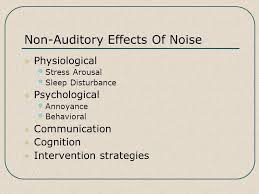W.B.C.S. Main 2018 Question Answer – Physiology – Non-Auditory Effects Of Noise.
WBCS ২০১৮ মেইনস প্রশ্নের উত্তর -শারীরবৃত্তি – শব্দের অ-শ্রুতি প্রভাব।
Noise – Non-Auditory Effects
Hearing loss from long term exposure to noise has been recognized as a hazard for a long time. Reported non-auditory effects of noise include increased stress, cardiovascular function (hypertension, changes to blood pressure and/or heart rate), annoyance, sleeping problems, and mental health. This wide range of effects has led researchers to believe that noise has the ability to act as a general, non-specific stressor.Continue Reading W.B.C.S. Main 2018 Question Answer – Physiology – Non-Auditory Effects Of Noise.
The response to noise may depend on characteristics of the sound including intensity, frequency, predictability, complexity of sound, duration (length of exposure), and the meaning of the noise.
In the workplace, non-auditory effects of noise also include problems with oral communications.
Note that this document focuses on non-auditory effects to individuals in workplaces. While there are many studies about environmental exposure to noise to the community and to children, these exposures are not the focus of this document.
What types of non-auditory effects are there?
Non-auditory effects can be divided into two categories – physiological effects and performance effects.
What are some examples of physiological effects?
The physiological effects can be temporary or permanent.
Examples of temporary physiological effects are:
- The startling response to loud noise, where muscles burst into activities, generally, with the intention to protect.
- The muscle tension response, where muscles tend to contract in the presence of loud noise.
- The respiratory reflexes, where the respiratory rhythm tends to change when noise is present.
- Changes in the heart beat pattern.
- Changes in the diameter of the blood vessels, particularly in the skin.
All those effects are similar to the response of the body to other stressors.
How can noise affect performance?
Noise can interfere with verbal communications and can be stressful, distracting and annoying. Below are some examples of how these factors can affect work performance.
Speech intelligibility
Speech intelligibility is the ability to understand spoken words. The presence of noise interferes with the understanding of what other people say, including hearing safe work instructions. This exchange includes face-to-face talks, telephone conversations, audible danger/warning signals, and speech over a public address system.
In order to be intelligible the sound level of speech must be greater than the background noise at the ear of the listener. People with otherwise unnoticeable hearing loss find it difficult to understand spoken words in noisy surroundings.
In noisy work situations, people are able to converse with difficulty at a distance of one meter for a short time in the presence of noise as high as 78 dB(A). For prolonged conversations, the background noise level must be lower than 78 dB(A).
In social situations people often talk at distances of 2 to 4 meters. In such cases noise level should not exceed 55 to 60 dB(A).
| Speech Communication Capability versus Level of Background Noise in dB(A) |
|||||
|---|---|---|---|---|---|
| Communication | Below 50 dB(A) | 50-70 dB(A) | 70-90 dB(A) | 90-100 dB(A) | 110-130 dB(A) |
| Face-to-face (unamplified speech) | Normal voice at distances up to 6 m | Raised voice level at distances up to 2 m | Very loud or shouted voice level at distances up to 50 cm | Maximum voice level at distances up to 25 cm | Very difficult to impossible, even at a distance of 1 cm |
| Telephone | Good | Satisfactory to slightly difficult | Difficult to unsatisfactory | Use press-to-talk switch and an acoustically treated booth | Use special equipment |
| Intercom system | Good | Satisfactory | Unsatisfactory using loudspeaker | Impossible using loudspeaker | Impossible using loudspeaker |
| Type of earphone to supplement loudspeaker | None | Any | Use any earphone | Use any in muff or helmet except bone conduction type | Use insert type or over-ear earphones in helmet or in muffs; good to 120 dB(A) on short-term basis |
| Public Address System | Good | Satisfactory | Satisfactory to difficult | Difficult | Very difficult |
| Type of microphone required | Any | Any | Any | Any noise-canceling microphone | Good noise-canceling microphone |
Annoyance
Noise is annoying. In noisy environments, people generally prefer to reduce the noise loudness, avoid it, or leave the noisy area if possible. The same noise could be annoying to some people but acceptable to others. There is no definite relationship between the degree of annoyance or unpleasantness of noise and the risk of adverse health effects. For example, very loud music may be pleasant to one group of people and annoying to another group. Both groups will be equally at risk of hearing loss.
Besides loudness of sound, several other factors contribute to annoyance. The following table lists examples of such factors:
| Factors that affect Individual Annoyance to Noise | |
|---|---|
| Primary acoustic factors | Sound level Frequency Duration |
| Secondary acoustic factors | Spectral complexity Fluctuations in sound level Fluctuations in frequency Rise-time of the noise Localization of noise source Physiology |
| Nonacoustic factors | Adaptation and past experience How the listener’s activity affects annoyance Predictability of when a noise will occur Is the noise necessary? Individual differences and personality |
Our own publications are available at our webstore (click here).
For Guidance of WBCS (Exe.) Etc. Preliminary , Main Exam and Interview, Study Mat, Mock Test, Guided by WBCS Gr A Officers , Online and Classroom, Call 9674493673, or mail us at – mailus@wbcsmadeeasy.in
Visit our you tube channel WBCSMadeEasy™ You tube Channel
Please subscribe here to get all future updates on this post/page/category/website



 +919674493673
+919674493673  mailus@wbcsmadeeasy.in
mailus@wbcsmadeeasy.in






































































































